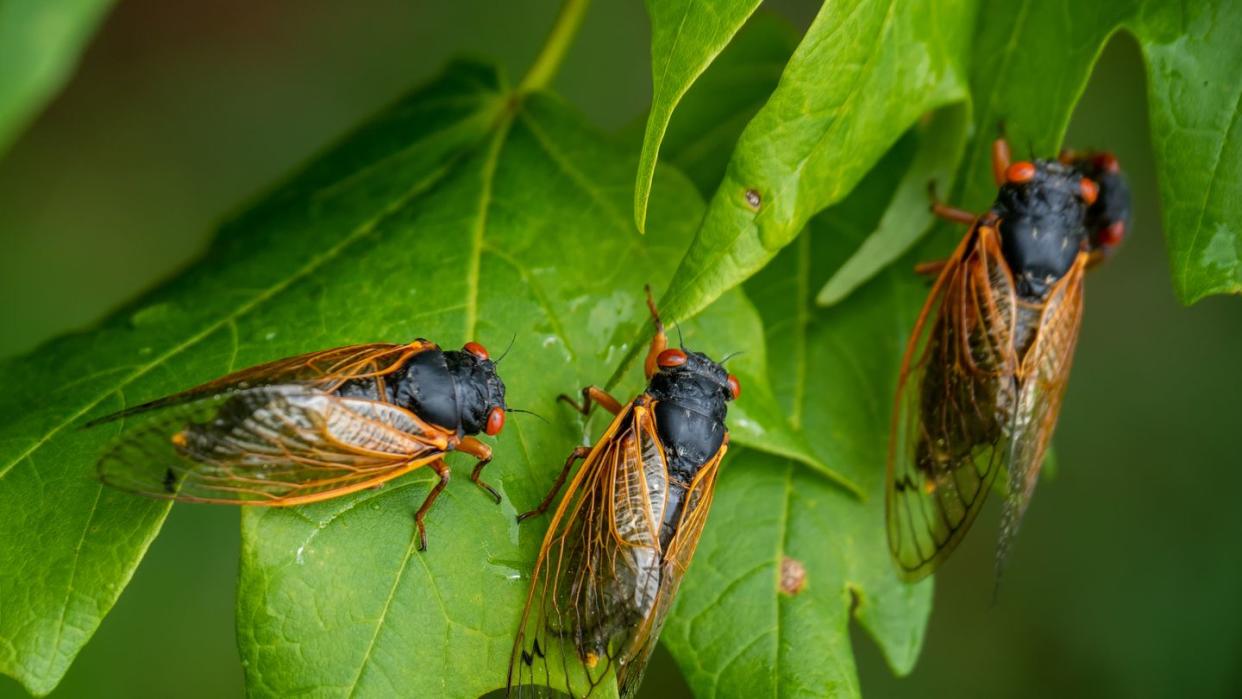Are Cicadas Dangerous? Do They Bite? Here’s the Scoop, According to Experts

This summer, you can expect to be awoken by chirping, fluttering fauna outside your windows. And no, we aren't talking about morning blackbirds, or even robins, but cicadas!
If anything defines the year 2024, it's the plethora of natural phenomena we have the pleasure of experiencing. Like the total solar eclipse that passed through our skies in the spring, this summer brings us yet another once-in-a-lifetime occurrence: the cicada double brood!
In short, the stars have aligned to bring an influx of the chittering, winged insects to our front doors this summer. For the first time since 1803, Brood XIX (13-year periodical cicadas) and Brood XIII (17-year periodical cicadas) have emerged, resulting in a swath of the cicadas throughout much of the United States, particularly among the Southern or southeastern parts of the country.
"There are folks traveling within their state, or sometimes across and through states, simply to be able to see these because when they come out, it's an amazing natural phenomenon," says PJ Liesch, an Extension Entomologist at the University of Wisconsin-Madison. "When these come out, it's not just in small numbers, it's really by the millions and billions and trillions of them."
Whether or not you're afraid of pests, you're probably wondering what this influx of insects means for your summer. Luckily, we got the inside scoop on all things cicada from Liesch—also known as "the Wisconsin Bug Guy"—who spoke to us about whether cicadas are dangerous, if they bite, and more about their impact on your life and garden!
Are cicadas dangerous?
The gargantuan clusters of cicadas that we expect to see this summer may be overwhelming, but they aren’t dangerous. “These periodical cicadas are pretty defenseless: they're clumsy, they don't have chemical defenses, they're quite palatable to a wide range of animals," says Liesch.
Cicadas are a source of food for a range of animals, including fish, turtles, birds, and even mammals, like raccoons and squirrels. Given that, the otherwise vulnerable insects turn to a little something we know as 'strength in numbers.'
"The idea is so many of them come out that the predators that feed upon them essentially get a full tummy, and they can't eat anymore. That leaves all the other ones around to go about their business of singing, attracting mates, and laying eggs,” he says.
Do cicadas bite?
Cicadas may not be particularly dangerous, but neither are cats—and they still bite! If you're questioning what insect is responsible for that itchy red lump on your forearm, it's safe to say you can take cicadas out of the lineup. "In general, cicadas tend to be pretty darn harmless," says Liesch. Because they don't have the proper mouthparts found in other nipping critters, "They really can't bite, they're not able to sting."
Are cicadas dangerous to pets?
Okay, so they can't bite or sting, but do cicadas pose a threat to our furry friends? According to Liesch, cicadas aren't particularly dangerous to dogs, cats, or other pets in your home. “They are not toxic by any means, but if you had a pet that happened to eat a very large quantity of them, it's possible that might cause some GI symptoms," he says. "It's best to use moderation in a case like this.” So while your fur babies can enjoy a crunchy cicada or two as a summer snack, as long as they don't go overboard, they should be fine!
Are cicadas harmful to plants?
Although Liesch doesn't recommend spraying for cicadas or trying to get rid of them in any way, the otherwise harmless insect can pose a slight problem to plants. Female cicadas insert their eggs into twigs and small branches after mating, which can cause the twigs to break off and develop brownish leaves. "For a large mature tree, this will be noticeable and conspicuous, but it really poses no health threat to the plant whatsoever. The plants simply shrug off that sort of damage," he says.
On the other hand, recently planted small shrubs or trees may acquire damage from the cicadas' egg insertion process. In that case, Liesch suggests that you "buy some fine mesh netting, cover the canopy of those plants, and secure it at the base of the plant," he explains. "That will act as a physical barrier; if the insects can't get to the plants, they can't damage them."
What are cicadas?
If their characteristic buzzing isn't enough of a defining factor, allow us to paint a picture of the summer insect. While their chittering may sound the same, there are over 170 different species of cicadas from North America and over 3,000 species worldwide. These sound-producing insects range from 0.8 to 2 inches in size and are black in color with orange-veined wings and bright red eyes.
As for when you can expect cicadas to pop into your summer plans, "Their emergence is linked to soil temperature; the soil temperature at a depth of eight inches has to get up to about 64 degrees for them to emerge," Liesch says. "Wherever you're located, once the adults start appearing, they're going to be present for about four to maybe six weeks." In Southern states that experienced warmer temperatures earlier, cicadas are already starting to dwindle for the year, while the upper Midwest still has a few more weeks with the insects!
You Might Also Like

